Your browser does not fully support modern features. Please upgrade for a smoother experience.

Submitted Successfully!
Thank you for your contribution! You can also upload a video entry or images related to this topic.
For video creation, please contact our Academic Video Service.
| Version | Summary | Created by | Modification | Content Size | Created at | Operation |
|---|---|---|---|---|---|---|
| 1 | Giovanni Incerti | -- | 7009 | 2024-02-09 12:01:53 | | | |
| 2 | Jason Zhu | Meta information modification | 7009 | 2024-02-18 03:07:49 | | |
Video Upload Options
We provide professional Academic Video Service to translate complex research into visually appealing presentations. Would you like to try it?
Cite
If you have any further questions, please contact Encyclopedia Editorial Office.
Sanguinetta, M.; Incerti, G.; Amici, C.; Legnani, G. Handbike for Daily Use, Sport, and Rehabilitation Purposes. Encyclopedia. Available online: https://encyclopedia.pub/entry/54965 (accessed on 13 January 2026).
Sanguinetta M, Incerti G, Amici C, Legnani G. Handbike for Daily Use, Sport, and Rehabilitation Purposes. Encyclopedia. Available at: https://encyclopedia.pub/entry/54965. Accessed January 13, 2026.
Sanguinetta, Michele, Giovanni Incerti, Cinzia Amici, Giovanni Legnani. "Handbike for Daily Use, Sport, and Rehabilitation Purposes" Encyclopedia, https://encyclopedia.pub/entry/54965 (accessed January 13, 2026).
Sanguinetta, M., Incerti, G., Amici, C., & Legnani, G. (2024, February 09). Handbike for Daily Use, Sport, and Rehabilitation Purposes. In Encyclopedia. https://encyclopedia.pub/entry/54965
Sanguinetta, Michele, et al. "Handbike for Daily Use, Sport, and Rehabilitation Purposes." Encyclopedia. Web. 09 February, 2024.
Copy Citation
With respect to alternative devices like traditional wheelchairs, handbikes can offer advantages from biomechanical and physiological perspectives, to several kinds of users. Assuring high mechanical efficiency and homogeneous force distributions along cycles, and being suitable for indoor and outdoor activities, these systems are used for rehabilitation, sports, and daily applications. From a technical perspective, their main characteristics can vary with the device final purpose and operational context.
handbike
wheelchair
handcycling
actuation
propulsion
1. Introduction
Handbikes are vehicles composed of two-rear wheels and one front wheel. The latter is connected to a handle through a roller chain, which is able to increase the mechanical efficiency, with respect to traditional wheelchairs, up to 15 [1]. Handbikes may present various architectures to adapt to the needs of different users. Figure 1 collects the most common kinds of handbikes. Besides the most traditional solutions, nowadays hybrid devices are also available, which functionally transform wheelchairs into handbikes by adding custom or off-the-shelf attachments to traditional wheelchairs. In the present work, only integrated devices, realized as a whole to enable handcycling, and often referred to as fixed-frame devices, will be properly considered as handbikes; hybrid solutions will be also partially described, but an analysis of these systems is outside the main purpose of the present work. Figure 2 presents an example of the considered handbikes, depicting the main components of this kind of devices and synthesizing the basic applied nomenclature.
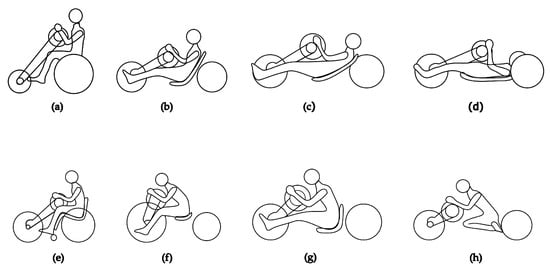
Figure 1. Schematic of the most common kinds of handbike architectures, divided into arm propulsion on the upper row, and arm trunk propulsion on the lower row, with: (a) attach unit handbike, (b) recumbent 60° rigid frame, (c) recumbent 30° rigid frame, (d) recumbent 0° rigid frame, (e) attach unit handbike, (f) car-seat, (g) long-seat, and (h) knee-seat.
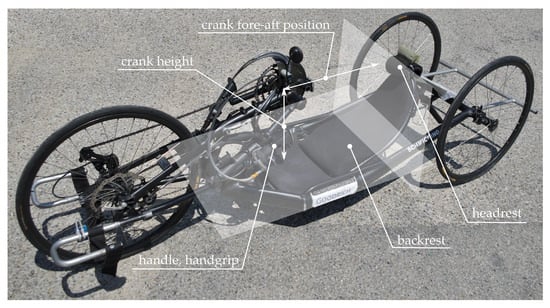
Figure 2. Example of handbike: main components and basic applied nomenclature. Modified version of the image by C. Bucco-Lechat, 2014 [2].
According to literature, using a handbike for daily life confers advantages from a biomechanical and physiological point of view with respect to traditional wheelchairs for several kinds of patients, like subjects affected by spinal cord injury (SCI) [3][4].
For instance, as observed in the work by Dallmeijer et al. of 2004 [5], the propulsion of a handbike depends on a closed-chain motion, and the force applied to the handle contributes to movement during all the 360° of the motion cycle. Furthermore, in a work of 2012, Arnet et al. [6] shows that the force distribution is more homogeneous during an entire handle rotation of the handbike, also referred to as the hand-cycle, than during an analogous wheelchair cycle. This is due to the fact that, for the handbike, an individual’s hands are always in contact with the handle during the propulsion act; for the wheelchair instead, the hands have to transmit sufficient force on the wheel generating movement in a short amount of time. As a result, the force during a wheelchair cycle presents peaks three times higher than a handbike, and generates significant torques at the shoulder joints. Over time, this condition could lead to overuse injuries called repetitive strain injuries (RSI).
Another advantage of the handbike is its versatility. Handbikes can be used outdoors and indoors and for different purposes, such as for training, also attached to a traditional ergometer, or to follow rehabilitation programs. In this latter case, handbikes can be equipped with specific components, like additional gears assuring different gear ratios, as shown in the study by Van Der Woude et al. [7], to confer fluidity to the movement and enhance mechanical efficiency.
Focusing on technical solutions, the backrest deserves particular attention. Indeed, the backrest can be reclining as well as not even present, according to the needs of the user and the severity of their impairment, or depending on the UCI (Union Cycliste Internationale) rules in the case of racing.
The kind of propulsion can also be classified into two types: synchronous and asynchronous. According to the works conducted by Kraaijenbrink et al. [8][9], the synchronous mode with the extra use of trunk is the more efficient way to propel a handbike in terms of power production and vehicle conduction.
Furthermore, handbikes also play an important role in rehabilitation. As exposed in the work of Nooijen et al. [10], wider physical benefits like greater power production and maximal oxygen consumption have been detected in the SCI subject when handbike training was added to the traditional rehabilitation program. In addition, a cross-sectional study by Van Der Woude et al. [11] reveals that handcycling is an effective intervention, which is able to maintain an active lifestyle and enables preventing secondary health conditions like pressure sores, urinary tract infections, osteoporosis, upper-extremity pain and cardiovascular diseases.
According to the Scopus database, the interest of the scientific community in handbikes and their features has remarkably increased since 2008, reaching a peak in 2021 and 2022 with 20 published documents every year, as Figure 3 depicts. Within all the published documents, only seven were classified as reviews according to Scopus.
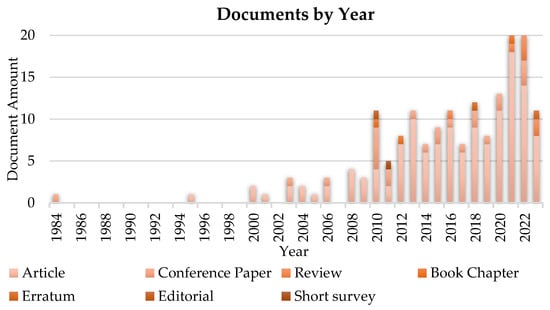
Figure 3. Documents referring to the “Handbike” topic in the Scopus database, by year.
Among the first literature reviews, there is the work published in 2016 by Rice et al. [4]. However, more than outlining an overview of the overall scientific literature from a broad perspective, the paper mainly focuses on the specific topic of the technology used in sports where a wheelchair is needed. In 2021, Flueck et al. [12] present a narrative review, but centered it on nutritional considerations for para-cycling athletes. Finally, Nevin et al. [3], Goodlin et al. [13], and Rayes et al. [14] published three additional review works in 2022. In the first one, Nevin et al. proposed a narrative review of the handbike analyzing 49 documents, focusing on biomechanics and physiology characteristics of competitive handcycling, such as seat positioning, crank height, and fore-aft position, as well as peak aerobic power output, and relative upper body strength, suggesting practical training of the human upper body for competitive performance. The work by Goodlin et al. [13] instead depicts an overview of para-cycling, including evaluations on technological solutions from tandem cycling, to handcycling, to tricycles. Similarly, Rayes et al. [14] describe adaptive sports for the SCI subject, including the handbike, among several others, without a dedicated focus.
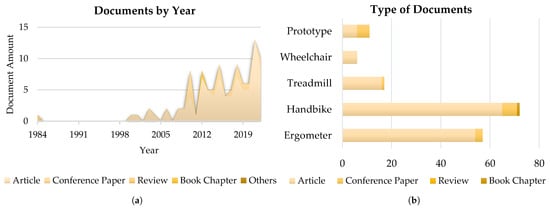
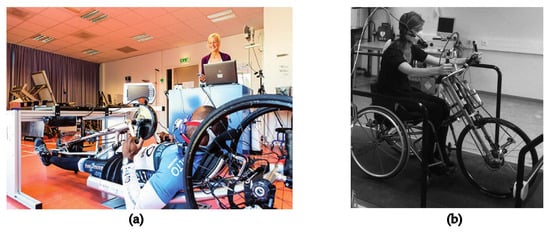
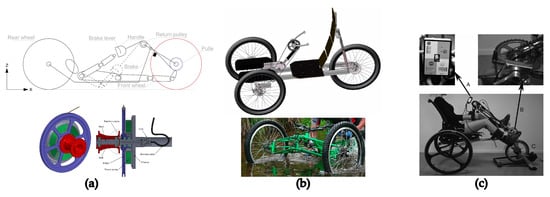
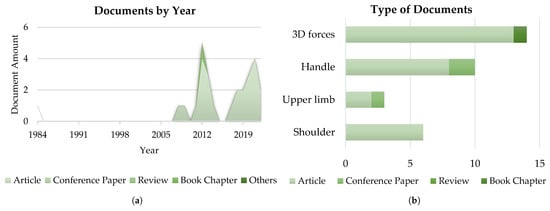

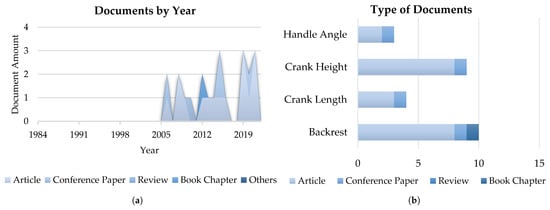
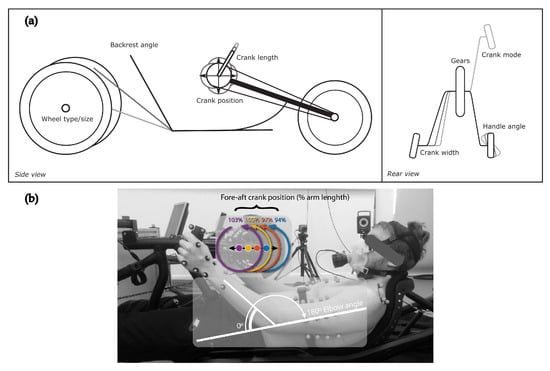

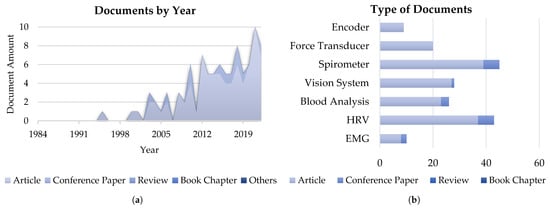
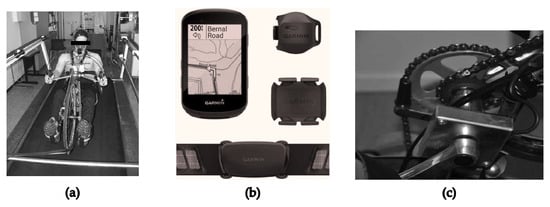
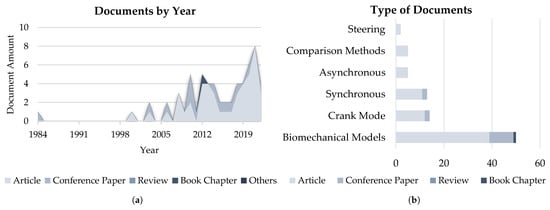



2. Device
The documents for the Device category were distributed as follows: 85 articles, 15 conference papers, and 1 book chapter, as shown in Figure 9a. The increase in publications became relevant from 2012, although a peak in 2010 with four articles and four conference papers emerged.

Figure 9. Device category: (a) evolution of documents in time, and (b) number of documents in each sub-class for the device category, divided by document type.
Device Sub-Classes
The device category was subdivided into sub-classes, each related to different methods for analyzing hand propulsion in subjects, as indicated in Figure 9b. In the same figure, the distribution of documents reveals that articles are the predominant form of publication in each sub-class.
Focusing on the content of the documents, different aspects that affect the device are collected in this class; Figure 10 presents some examples of these elements, whereas Figure 11 collects illustrative examples of handbike prototypes at a glance.


Figure 11. Examples of prototypes: from the left, (a) an innovative propulsion system applied to a recumbent handbike (source: Quaglia et al., 2019 [17]), (b) a multi-adjustable handbike chassis for off-road use (source: Siebert, 2010 [18]), and (c) a hybrid cycle showing the detail of the mounted stimulator (source: Bakkum et al., 2014 [19]).
Ergometer
In 57 cases, an ergometer was used to perform handbike tests. The most used ergometer is the Cyclus II (RBM elektronik-automation GmbH, Leipzig, Germany), which was utilized 29 times, followed by Tacx Flow (Technische Industries, Waibstadt, Germany) in 6 studies, and CycleOps Fluid 2 (Saris, Medison, WI, USA), which was used once.
Handbike
According to data, handbikes were utilized 72 times; 5 of those instances involved outdoor activities or races, and in 17 studies the handbike was mounted on a treadmill, to simulate road conditions or control handle velocity in comparative studies with wheelchair users. Among the most frequently used handbikes Shark RS, Spirit 468, Spirit 469, and Spirit 470 (Sopur, Sunrise Medical, Malsch, Germany) have been identified. These devices were used in experiments 16 times. The Tracker Tour (Double Performance, Gouda, The Netherlands), a wheelchair attach-unit, was mentioned seven times. Finally, the BerkelBike Pro (BerkelBike B.V., St Michielsgestel, The Netherlands) was used in three experiments; this device is defined as a hybrid-bike, as it combines synchronous handcycling with asynchronous Functional Electrical Stimulation-induced leg cycling.
Treadmill
In the study conducted by Abel et al. [1], a motor-driven treadmill was employed to elicit the subject’s physiological responses at maximum load one week before the race. The treadmill velocity was set at 12 km/h, with a progressive increase of 2 km/h every 3 min. Abonie et al. [20], on the other hand, utilized a motor-driven treadmill with a constant power output to achieve 30% of the participant’s Heart Rate Reserve (HRR).
Arnet et al. and Hettinga et al. [16][21] employed a motor-driven treadmill to simulate different velocities and slopes. The treadmills used in these studies were the Mill (Forcelink, Culemborg, The Netherlands) and the Mill-track (Enraf Nonius, The Netherlands).
Arnet et al., Kraaijenbrink et al., and Schoenmakers et al. [21][22][23] incorporated a pulley system in conjunction with a motor-driven treadmill to maintain an external power output. For Kraaijenbrink and Schoenmakers, the treadmills used were the Motek force Link b.v. (Motek Medical B.V., Houten, The Netherlands) and Mill-track (Enraf Nonius, The Netherlands), respectively.
Wheelchair
The documents classified in the Wheelchair sub-category allow the investigation of analogies and differences between handbike and wheelchair use. Wheelchair propulsion is used in some cases as a baseline for comparison, given the higher popularity of this topic in the scientific literature, which makes it a de facto gold standard [5][24][25].
In other cases, like in the work by Nooien et al. of 2015 [10], the handbike is used as an experimental setup tool, to enable the acquisition of the relevant data in the defined protocol. In fact, unlike what happens in wheelchair propulsion, during handcycling, user and device create a closed kinematic chain: this makes subsequent cycles and repetitions more standardized and comparable, reducing the potential variability of the task across sessions and across subjects [26].
Prototype
Regarding prototypes, several of the analyzed papers focus on wheelchairs more than handbikes mockups. For instance, Chong et al. [27] introduce a new type of wheelchair, aiming to catalyze the development of such devices for children with cerebral palsy. This wheelchair meets the 3As criteria, focusing on availability, accessibility, and affordability. It is equipped with a heartbeat monitoring system, training programs, and a user interface, making it a promising tool in this domain.
In the work conducted by Quaglia et al. [17], an innovative propulsion system is proposed, named Handwheelchair. In this case, the mechanism works as an attachment that functionally transforms a wheelchair into a handbike.
Instead, Siebert et al. [18] addressed two primary challenges associated with handbikes: traction optimization, as most of the weight rests on the two non-driven rear wheels, and the inability to simultaneously pedal and steer in off-road handbiking. To address these issues, a new prototype was developed featuring two steerable front wheels, one of which is powered, allowing users to pedal and control the device with both arms simultaneously. Additionally, a multi-adjustable backrest was incorporated to accommodate the specific requirements of individual users.
3. Forces
The Forces category collects a total of 25 articles, 4 conference papers, and 1 book chapter, as indicated in Figure 12a. The distribution of documents dealing with the forces exerted during handcycling reveals a first peak of interest in 2012, with the publication of five documents, and another peak in 2021, with four published articles.

Figure 12. Forces category: (a) evolution of documents in time, and (b) number of documents in each sub-class for the forces category, divided by document type.
Forces Sub-Classes
Within the sub-classes, 10 documents investigated the forces at the handle, 6 at the shoulder, and 3 performed the analysis considering the whole upper limb. Notably, 14 papers explored forces in a 3D context, moving beyond the sagittal plane to offer a comprehensive view of the results (see Figure 12b). Articles represent the predominant type of publication in the Forces class. Most of the documents address the study of 3D forces, with 13 articles and 1 book chapter, representing 56% of the overall production. The peak of works on this aspect was in 2012.
Figure 13 presents some examples of schematics for the evaluation of 3D forces on the handle depicted in the analyzed literature.

Figure 13. Examples of schematics for the evaluation of the forces exchanged between subject and handbike at the handle level: from the left, an example of (a) model (source: Faupin et al., 2010 [28]) and (b) real setup (source: Kraaijenbrink et al., 2017 [23]) of 3D force measurement on the handle during handcycling.
Shoulder
The shoulder is among the anatomical areas that are more involved in handcycling. Among the six documents classified within this category, Arnet et al. proposed a comparison between handbike and wheelchair performance [6][25]. In the first study conducted by Arnet et al. [6], eight subjects with paraplegia underwent testing while propelling both a handbike and a wheelchair at different power output levels (25, 35, 45, and 55 W). The treadmill speed was adjusted to 1.6 m/s for the handbike and 1.11 m/s for the wheelchair, aiming to simulate everyday propulsion conditions. The estimated force exerted on the rotator cuff during handbiking was approximately 268 N, marking a 29% reduction compared to the force generated when using a wheelchair at a constant power output of 25 W. This discrepancy grew at a constant power output of 55 W, with the handbike recording a force of 345 N, representing a 70% decrease compared to the wheelchair. During handcycling, glenohumeral contact forces were distributed across the entire cycle, reaching their peak at the end of the cycle. In contrast, wheelchair propulsion exhibited a force peak in the middle of the push phase, with smaller peaks at the beginning and end of the recovery phase. Regarding muscle activation, the supraspinatus and infraspinatus muscles were most engaged during handcycling. Arnet et al. [6] reported that their percentage of activation during handcycling was less than 5%, reducing the risk of overuse injuries compared to traditional wheelchair use and making the handbike a suitable device for daily use.
In the second study, Arnet et al. [25] focused on the impact on the shoulder joint caused by external force production during an entire handbike cycle or in the push phase of the wheelchair on different slopes. Across all slope variations, the force acting on the handle (Total Force and Mean Force calculated over the last 30 s of each repetition) was approximately three times lower during handcycling compared to wheelchair propulsion. Additionally, Fpeak was about 60 N for the handbike and 160 N for the wheelchair during the push phase, resulting in lower torque on the glenohumeral joint and reducing the risk of shoulder injuries.
The position of the backrest and the crank position were also found to influence shoulder load. Arnet et al. [29] demonstrated that an upright backrest position led to lower shoulder load and reduced muscle activation (specifically the supraspinatus and infraspinatus), while mechanical efficiency, calculated, according to the definition proposed by Kraaijenbrink in 2017 [23], as the percentage of Power Output PO over Energy Expenditure EE, remained constant. However, no significant differences were observed when changing the crank position.
Upper Limb
For the analyzed data, three documents were classified in the Upper Limb category [30][31][32]. Among their findings, Nevin et al., in a work of 2021 [30], state that there is a strong correlation between strength tests and handcycling performance. The authors conducted tests on 13 UCI male handcyclists belonging to H3/H4 categories, which included a graded exercise test, a 15 s all-out sprint, and a 15 km Individual Time Trial, and the study revealed a significant relationship between upper body strength and handcycling performance. Specifically, improvements in maximal upper body strength led to enhanced gross mechanical efficiency in handbiking. This allowed cyclists to generate the same power output while minimizing the workload required to produce it. Higher mechanical efficiency can also extend the endurance of type I muscle fibers, delaying the activation of less efficient type II fibers. Additionally, there was an observed improvement in strength stiffness, resulting in a better mechanical transmission of force to the handle.
Handle
In works dealing with the handbike handles, particular attention is paid to the interaction with the user in terms of force exchange and propulsion optimization. For instance, in the case of van Drongelen et al. [33], force measurements were taken by replacing the handle’s stud with a force transducer, providing three voltage outputs related to the three force components. Encoders were positioned between the handgrip and the handle, and between the handle and the crank, to express forces in the global coordinate system of the bike. According to the authors, the force characteristics can be influenced by several parameters, including crank speed, crank height, and power output.
Arnet et al. [21] studied the correlation between handle speed and force characteristics. They found that, at a constant power output (PO) and gear setting, an increase in crank speed led to a decrease in both total force (Ftot) and tangential force (Ftan), from 24.2 N to 18.2 N and 20.0 N to 13.5 N, respectively. However, at higher speeds, Ftot and Ftan did not decrease uniformly across all sectors of the cycling motion, resulting in the Force Effectiveness Fraction (FEF) not decreasing in every sector. FEF decreased in the sector where gravity acted against the crank’s movement but increased in other sectors. Due to the complex nature of the upper limb joint framework, applying force becomes less efficient at higher velocities. Therefore, selecting a lower gear ratio is advisable to maintain a sufficient FEF. The analysis of the relative work produced in each sector revealed that, in sectors where less work was generated (e.g., “lift up” against gravity), work decreased with greater speed, possibly due to inertia. However, in areas where the highest amount of relative work was produced (e.g., “pull down” and “press down”, following gravity), the relative work increased with increasing speed. This was because, due to inertia, the crank rotated evenly without the need for high force application.
Kramer et al. [34] also demonstrated an increment in work production during the pull-down phase, suggesting an improved efficiency. Modifying handle angles, particularly a pronated 30° angle, has been shown to enhance the work generation and increase the efficiency of handcycling.
Jacquier-Bret et al. [35] introduced a new index called the Postural Force Production Index (PFPI) to evaluate force production in handcycling. This index considers both the rotation of the handgrips and the patient’s ability to generate force from their current posture. The fore-aft position, i.e., the longitudinal position of the crank with respect to the subject’s shoulder, also affects the force application and the distribution of relative work.
Vegter et al. [36] tested participants without disabilities on a recumbent handbike at different crank-fore-aft positions (103%, 100%, 97%, 94% of arm length), at two different power outputs (30 W and 60 W). Increasing the crank distance correlated with a decrease in elbow flexion and an increase in shoulder protraction, shifting work production to the pull phase, where the highest torque was recorded. For a more consistent power output, which is useful in daily life, a shorter crank-fore-aft position is recommended to evenly distribute work production throughout the entire cycle, maintaining handle velocity as consistently as possible.
4. Geometry
According to the literature, 22 documents have been published for the Geometry category: in particular, 16 articles, 5 conference papers, and 1 book chapter. Figure 14a describes the evolution of scientific production over time, identifying three peaks, in 2015, 2019, and 2021, with three documents each.

Figure 14. Geometry category: (a) evolution of documents in time, and (b) number of documents in each sub-class for the geometry category, divided by document type.
Geometry Sub-Classes
Regarding the sub-classes, most of the studies investigate changes in the crank height and backrest. Backrest has been analyzed in 10 documents, of which 8 are articles, 1 is a conference paper, and 1 a book chapter, whereas crank height has been studied in 8 articles and 1 conference paper. The distribution of sub-classes publications is represented in Figure 14b. Paper production is concentrated in three specific time windows: between 2006 and 2010, 2012 and 2017, and from 2018 to 2022. A higher level of production was reached in the second period, with a focus on crank and backrest. Most of the production is represented by articles for all sub-classes.
Some examples of the different aspects that could be evaluated in the documents included in the Geometry class are illustrated in Figure 15.

Backrest
In 2014, Arnet et al. [29] demonstrated that altering the backrest inclination affects the glenohumeral contact force and the forces exerted by the supraspinatus and infraspinatus muscles but does not affect mechanical efficiency. Decreasing the backrest inclination led to an increase in mean and high peak glenohumeral contact force; this phenomenon is particularly noticeable in the lying position, which is common in handbike cycling. Consequently, the lying configuration presents a higher risk of overuse injuries compared to other backrest conditions. Their findings suggest that the most optimal inclination stands at 60°, resulting in the lowest shoulder load. Litzenberger et al. [38] corroborate this outcome by testing a world-class male handbiker across various parameters. They found that a lower backrest position increased the elbow range of motion (ROM), while the opposite was true for higher backrest positions.
The effect of backrest inclination on handcycling performance is so relevant that handbikes can be classified as Arm-Powered or Arm Trunk-Powered depending on this value. The inclination can assume a fixed value, as 90° in the attach-unit handbike, which often presents a motor drive system, or may range from 0° to 60°, depending on factors such as: kind of use (e.g., race or mobility), severity of impairment, or UCI categories (e.g., H1, H2, H3, H4, and H5). In fact, backrest inclination affects several biomechanical factors, such as the trunk flexion/extension, the power production, the crank velocity, and the muscles recruitment.
Crank
Crank position and crank length are fundamental parameters for what concernes handbike daily use. In fact, crank geometry is strongly related to ROM of the upper limb, muscle activation, and force expressed on the crank itself or in shoulder joints. Faupin et al. [39] described a kinematic model with seven degrees of freedom, presenting as input quantities the lengths of the patient’s arm segments, the shoulder position, and the size of the crank; the output of the model was the joints kinematics. To achieve an optimal position, i.e., one that reduces the risk of repetitive strain injuries (RSI), by moving the crank axis or modifying the distance between cranks, the following indications were identified:
-
The distance between left and right extremes of the crank is to be set equal to the distance between the shoulders;
-
The crank height should remain below the axis passing through the acromions;
-
The crank should be positioned so as to avoid complete elbow extension.
In the study conducted by Vegter et al. [36], untrained subjects with disabilities were examined on a recumbent handbike at a consistent power output of 60 W. They found that increasing the distance between the acromial angle and the handle’s center, specifically at 94%, 97%, 100%, and 103% of the arm’s length, resulted in decreased elbow flexion (from 42° to 29°) and a more pronounced shoulder protraction (from 29° to 36°). This alteration shifted the distribution of work during the pull phase, with 69% of the work being produced at the 103% arm length position. However, since handbike races and daily activities benefit from a more equal distribution of work and fatigue among muscle groups, a shorter crank-fore-aft position is favored. This not only aids in reducing speed fluctuations but also helps evenly distribute fatigue. Interestingly, there were no observed effects on VO2, mechanical efficiency, or heart rate when choosing the most extended crank fore-aft position.
The work by Stone et al. [40] was conducted under similar conditions, with a horizontal crank positioned at 97% of the arm length, and with this configuration the authors found more favorable handcycling conditions. This positioning improved the musculature surrounding the joints, enabling more economical force production. Stone et al. discovered that, at 70% of athletes’ peak power output, the 97% position was 4% more economical than the 94% and 103% positions. Such data hold significance in endurance competitions or longer activities, where energy-saving measures can influence final results. While the crank length in normal handbikes during professional competitions can vary from 150 mm to 180 mm, the physiological economy remains unaffected by changes in crank length. However, shorter crank lengths are favored during races due to the reduced frontal areas that they offer, which become especially smaller when the crank is at the top dead center, subsequently decreasing air resistance and creating more advantageous conditions. Litzenberger et al. [41] reported that shorter cranks led to higher electromyography (EMG) values for the upper limb muscles throughout the cycle. Moreover, the crank length is related to the number of revolutions per minute (rpm) that the subject can comfortably express. A 190 mm crank length suits a cadence of 180 rpm, while a length of 139 mm is favorable for 125 rpm. Thus, depending on the conditions, crank length can remarkably influence handbike performance.
Handle angle
During handcycling, force is transmitted to the crank through the handle grip. Abel et al. [42] tested participants without disabilities, with incremental tests to exhaustion performed with the three different hand grip angles presented in Figure 16: 0° for a horizontal configuration, 90° for a vertical configuration, and 10° for a diagonal configuration. For each angle, four parameters were evaluated, i.e., peak functional performance (W/kg), peak heart rate (bpm), associated lactate concentrations (mmol/l), and peak oxygen uptake per kilogram of body weight (Ml/min·kg). No significant differences emerged among the three hand grip angles for any parameter, but the vertical position seems to be less efficient than the horizontal and diagonal in the analysis of the lactate concentration. Kramer et al. [34] focus on the correlation between handle angle and work distribution. The effect of the angle on the work distribution is relevant in the pull-down and lift-up phase. In these phases, a higher work production was achieved with angles of −15° and 30°, but the phenomenon of premature fatigue related to these configurations should be further studied, since these results were obtained with a 30 s test.

5. Sensors
The Sensor category comprises 94 documents, divided into 83 articles and 11 conference papers. The presence of sensors within the set of analyzed documents has almost constantly increased since the beginning of the millennium, reaching a peak in 2021 with 15 published papers (see Figure 17a).

Figure 17. Sensors category: (a) evolution of documents in time, and (b) number of documents in each sub-class for the sensors category, divided by document type.
Sensors Sub-Classes
The sensors most commonly used for handbike measurements are synthesized in Figure 17b. The most applied devices are spirometers, with 45 publications. HRV sensors are also remarkably present, with 43 documents.
The analysis of the used sensors in time reveals a globally increasing trend in the last years. Often, documents state names and models of commercial devices, revealing that in scientific literature the most used sensors are generally produced by few companies, that are often key players in their market. Regardless of the various brands, the works involving EMG and optical cameras often provide the gathered data to biomechanical models, like in the cases of Litzenberger et al. [41], Quittmann et al. [43], or Mason et al. [44]. Similarly, the use of sensors for the assessment of physiological parameters is particularly common in the case of studies with a clinical focus, as in the works by Antunes et al. [45] or Stone et al. [46].
The analysis also allows appreciating the almost complete overlapping between documents classified in the Sensors category and in the Clinical Tests class, highlighting the strong relation between these aspects. Some examples of the sensors and devices described in the documents included in the sensors class are presented in Figure 18.

Figure 18. Examples of sensors used in the experimental setup of documents in the sensors category: from the left, (a) a spirometer used in V02 measurements (source: Abel et al., 2006 [1]), (b) a bike computer, a cadence sensor, and an HR sensor (source: Koontz et al., 2021 [47]), and (c) an encoder mounted on a handbike (source: Bakkum et al., 2014 [19]).
6. Actuation
According to the data, for the Actuation category 61 documents have been published; 46 works are classified as articles in the Scopus database, 14 as conference papers, and 1 as a book chapter (see Figure 19a). Also for this class, the analysis of the number of papers published in time reveals an increasing trend, with a peak in 2021 of eight documents.

Figure 19. From the left: (a) evolution of documents in time, and (b) number of documents in each sub-class for the Actuation category, divided by document type.
Actuation Sub-Classes
The distribution of documents by sub-class presented in Figure 19b reveals that most of the documents focus on biomechanical models, particularly articles (39 articles, making up 78% of the documents in the sub-class). The crank mode is investigated in 15 documents, mainly devoted to the study of the synchronous configuration (14 documents). Steering is especially evaluated in only three documents.
Figure 20 collects some illustrative examples of models applied to the investigation of the actuation propulsion included in the Actuation class.

Figure 20. Examples of actuation propulsion models: (a) details of a biomechanical model of the handcycling (source: Felsner et al., 2016 [48]), (b) schematic of synchronous and asynchronous handbike propulsion (source: Kraaijenbrink et al., 2020 [8]), and (c) a new type of handbike propulsion (source: Quaglia et al., 2019 [17]).
Biomechanical Models
Among the analyzed data, 51 documents investigated the propulsion task with biomechanical models. For instance, in the study conducted by Felsner et al. [48], a musculoskeletal model of a handcyclist was developed. The model was realized using the software AnyBody 6.0.5 (AnyBody Technology, Aalborg, DE). To validate the model, the muscle activity of the pectoralis major, deltoid, biceps brachii, and triceps brachii (TRIC), on both sides, was examined and compared to the recorded activity from a previous study, in which one male elite handbiker was tested. For the validation, different settings were considered (power level, crank height, crank length, and height of the backrest) and different muscles thresholds were applied, i.e., 10%, 20%, 25%, and 30% of the maximum muscular activity. To quantitatively assess the results, the mean overlap duration between the simulated and measured muscle activation phases was calculated. The overlap of muscle activation times ranged between 64% and 75%, satisfying the model validation. The most promising results were achieved using thresholds of 10% and 20% of the maximum muscular activity.
In the work by Mazzola et al. [49], a model was developed to describe the ergonomic behavior of a handbike to be assessed for elite competition. Information about the aerodynamic performance of the device was collected through an experimental campaign in wind tunnel. In the study, the results of ergonomic and aerodynamic tests are conflicting. The ergonomic analysis showed two key findings: increasing the length of the handlebar levers negatively affects ergonomic scores in all riding positions, and a more upright riding position is associated with lower perceived ergonomic discomfort. On the other hand, the vertical position of the torso has a negative impact on the aerodynamic drag coefficient, consistent with the observation that increasing the wind-exposed surface area leads to higher drag values. The results on handlebar lever length are also in contrast with the ergonomic analysis: longer levers seem to be more aerodynamically efficient.
Several papers then focus on specific aspects of the propulsion, like muscular activity [38][41] and activation patterns [43][50], techniques for the EMG signal processing [48][51], or shoulder loads, also assessed applying dedicated models such as Delft Shoulder or Elbow Model [52][53]. In 2010, Groen et al. [54][55] proposed a power balance model to describe the handcycling task, that enables the estimation of realistic values for power losses and power output, evaluating the physiological responses of subjects under given conditions (e.g., a range of regular velocities, on a treadmill or track). The model is expected to be a useful tool in the study of elite performance.
A different kind of approach is proposed in works with clinical purposes: in these cases, more than depicting new models that describe the handcycling task, models that combine physiological parameters are evaluated. In these works, predictive models are implemented, and ANOVA tests [8][23] or regression models, from linear, to hyperbolic and multilevel models [46][56][57][58][59][60], are generally applied to elaborate the data.
Finally, two additional works make use of models to evaluate the performance predictors: by Hettinga et al. [16] and de Groot et al. [61]. In particular, the first paper evaluates the physical stress and strain of handcycling by applying a set of training guidelines proposed by the American College of Sports Medicine; the latter analyzes a mountain time trial in handcycling in terms of exercise intensity in order to determine predictors of race time.
Crank mode
Since the handbike originally derives from traditional bikes, the handcycling crank was initially asynchronous, i.e., the cranks were mounted with a phase shift of 180 degrees. Over the years, handcycling has become more popular, and the crank mode has changed from asynchronous to synchronous, setting the cranks parallel.
In the work conducted by Kraaijenbrink et al. [8], twelve men without disabilities performed tests on handbikes, in both asynchronous and synchronous modes. The tests were performed by placing the handbike on a treadmill, which was set at a speed of 1.94 m/s; the resistance during the analysis was 15 W, and the crank length was 0.17 m. According to the authors’ data, in the synchronous mode the tangential force is maximum in the lift-push up phase, when the crank moves from the horizontal position towards the subject, with a module of 10 N. In the asynchronous configuration, the force is the highest during press-down phase (∼16 N). The radial force, i.e., the force that produces a torque around the steering axle, had a significant excursion in the asynchronous mode, ranging between its higher peak (20 N) and lower peak (−10 N). This variation causes high levels of muscles activation in order to stabilize the crank. An excursion is also seen in the synchronous mode, but presenting lower values (from 10 N to −10 N); nonetheless, the average radial force in this propulsion mode is equal to zero. The Force Effectiveness Fraction, FEF, was significantly higher during synchronous propulsion (50%) than asynchronous (25%); however, the synchronous mode was less efficient in the lift-pull up phases (from 0° to 90°), where the FEF is almost zero. The power production was more constant during asynchronous cycling throughout the cycle (∼12 W); in the synchronous mode, a lower power production is generated in the push phases (almost 0 W), and a higher power production (40 W) in the pull phases. The difference between push and pull phases during the synchronous cranking causes an acceleration and subsequent deceleration of the angular crank velocity. From a metabolic point of view, the same energy expenditure (EE) was consumed in the performed tests for both methods (3.5 W/kg); therefore, the synchronous mode was revealed to be more efficient, generating more power at the same cost. The mechanical efficiency (ME) was higher in the synchronous mode (6.5%) than in the asynchronous configuration (5%), while the heart rate (HR) was the same for both the modes (86 bpm).
Oviedo et al. [62] focused on physiological differences in SCI patients and subjects without disabilities, comparing asynchronous cranking on an ergometer versus the recumbent synchronous handcycling. For the initial set-up, the ergometer was set at 10 W. This value was incremented by 10 W each minute, until reaching the maximum value of 90 W. Significant differences were found by the authors, and the main numerical values detected during the tests are synthesized in graphical format in Figure 21. For the peak of the volume of oxygen uptake VO2 (see Figure 21a), significant differences were found between subjects without disabilities and SCI patients at all the workloads. In particular, ranging from 30 W to 90 W, the handbike seems to be more efficient than the ergometer for SCI subjects. The maximum difference is reached at 60 W. As Figure 21b depicts, the respiratory exchange ratio RER was lower for the SCI patients, in both the conditions of handcycling with handbike and ergometer, and a maximal difference of 0.28 was found at the workload of 80 W. Analyzing the heart rates synthesized in Figure 21c, SCI patients with asynchronous cranking depicted high values of HR for each workload, reaching a peak of 140 bpm at 90 W, and confirming that handcycling in the configuration of asynchronous crank ergometer is a mode of propulsion that requires a high activation of muscles.

Figure 21. From the left: (a) peaks of volume of oxygen uptake (VO2), (b) respiratory exchange ratio (RER), and (c) heart rate (HR), as detected by Oviedo et al. [62] with respect to power output. Data are compared for the different combinations of SCI patients (SCI) and subjects without disabilities (AB), and with traditional handbike (HB) and asynchronous crank ergometer (Acr).
Steering
Steering is the capacity to rotate the crank in order to change direction. In the work conducted by Kraaijenbrink et al. [9], sixteen subjects without disabilities were tested with both synchronous and asynchronous crank modes, with an ergometer also able to simulate steering effects. The resistance of the ergometer was set at 35 W, while the crank velocity was set at 3.3 m/s (60 rpm). In the study, the steering was revealed to have a significant effect on both the crank modes from a physiological point of view. From a kinetic point of view, the synchronous crank mode was more efficient than the asynchronous mode. In fact, in synchronous configuration, the FEF increased from 56%, when the fork axle is fixed, to 59% in steering condition. In asynchronous mode, the FEF decreased from 22% to 19%. The reason, as explained by Kraaijenbrink et al. [8], is that in synchronous handcycling the moments produced with respect to the steering axle are opposite, so the total moment is almost null throughout the cycle. In asynchronous handcycling, the moments produced are the same, causing a rotation of the front wheel, so more control and consequently more muscle activation is needed.
7. Final Remarks
In the analysis, a set of categories and sub-classes was identified and examined. Besides the information extracted by the application of the proposed taxonomy, additional interesting aspects emerged. For instance, a hint of the historical evolution of the handbike can be outlined, as synthesized in graphical form in Figure 22.

Figure 22. Handbike evolution: (a) the first handbike prototype made by Stephan Farffler in 1655 (image by V. Muratov, 2011 [63]), (b) a handbike with attach-unit (source: Dellmeijer et al., 2004 [5]), (c) a recumbent arm-powered road handbike (source: Siebert, 2010 [18]), (d) a touring handbike (source: Abel et al., 2006 [1]), (e) a race kneeling handbike (source: Belloli et al., 2014 [64]), (f) the “electric-assisted handcycle” by Jeang et al. (source: Jeang et al., 2015 [65]), and (g) a race recumbent handbike (source: Fischer et al., 2020 [66]).
An additional element is the relevance given in the scientific literature to the topics of comfort and discomfort of the handbike for the user. Attention is often afforded to the optimization of device configuration for performance improvement [39][55], but the sensibility of researchers is also towards ergonomics and usability of the system for the subject [40][49].
Literature also describes comparisons between handcycling and other tasks, especially hybrid-cycling [11][19][67][68][69][70]: these works generally present a clinical approach, and evaluate the comparison in terms of physiological parameters for the analyzed conditions.
Focusing on the design of new devices, besides the description of new handbike prototypes, some works depict innovative solutions for parts of the handbike: examples of these studies are the new transmission presented by Cavallone et al. [71], the new ergometer proposed by Verellen et al. [72], the new wheel rotation monitor by Hiremath et al. [73], or the new fork by Solazzi et al. [74]. These kinds of innovations may be difficult to capture with focused reviews, since the proposed systems can often be applied to different types of devices, like handbikes and wheelchairs. In this sense, interesting hints for the design of handbikes could also be extracted from the analysis of papers focusing on collateral topics. For instance, Florio et al. [75] investigated the unmet needs, use, and provision of assistive devices: handbikes are listed among the less frequently used devices, but are considered together with adapted cars and manual wheelchairs.
Interdisciplinary contamination among application fields is also at the basis of additional solutions, like the tandem bicycle proposed by Schwandt et al. [76], or the watercraft designed by Fuglsang et al. [77] by combining parts of a handbike and a waterbike.
As the relation between wheelchair and handbike is particularly close, literature also presents examples of attachments that enable the functional transformation of a wheelchair into a handbike. This is for instance the case for the studies proposed by Janssen et al. [78] and Dallmeijer et al. [5]. Moreno et al. identify an alternative solution, presenting the adaptation of an electric scooter to propel a conventional wheelchair [79], whereas Quaglia et al. design an innovative system of manual propulsion, defined as Handwheelchair.q [17].
Finally, few works deal with assistive or externally provided propulsion in handbikes. Siebert et al. [18] propose a powered rear wheel that can be mounted on the device instead of the traditional wheel, and nowadays some examples of analogous systems are also currently available on the market. The only case of an electric-assisted handcycle is presented by Jeang et al. [65]: the paper describes the design and development process of the device, from the concept definition to the release and testing of the first-generation prototype. For the actuation, few details are provided, but that the system incorporates a hub brushless motor which was tested for applicability and functionality by the various manufacturers that provided it. The lack of works on power-assisted solutions for handbikes in literature may be partially expected considering that handbikes are mostly used as a tool to improve mobility or to exercise in subjects with disabilities. Nonetheless, since the comfort of the user seems to be a particularly relevant element in the scientific literature on this topic, such a limited number of works still seems partially surprising. This is especially true when considering that few examples of power-assisted handbikes seem to be already available on the market. Given these considerations, a research focus also on this topic and on the development of handbikes equipped with external motors can be reasonably expected in the next future.
References
- Abel, T.; Schneider, S.; Platen, P.; Strüder, H. Performance diagnostics in handbiking during competition. Spinal Cord 2006, 44, 211–216.
- Bucco-Lechat, C. Wikimedia Commons. 2014. Available online: https://commons.wikimedia.org/wiki/File:Salon_de_l%27auto_de_Gen%C3%A8ve_2014_-_20140305_-_Skoda_Vision_C.jpg (accessed on 15 January 2024).
- Nevin, J.; Kouwijzer, I.; Stone, B.; Quittmann, O.; Hettinga, F.; Abel, T.; Smith, P. The Science of Handcycling: A Narrative Review. Int. J. Sport. Physiol. Perform. 2022, 17, 335–342.
- Rice, I. Recent Salient Literature Pertaining to the Use of Technology in Wheelchair Sports. Curr. Phys. Med. Rehabil. Rep. 2016, 4, 329–335.
- Dallmeijer, A.; Zentgraaff, I.; Zijp, N.; Van Der Woude, L. Submaximal physical strain and peak performance in handcycling versus handrim wheelchair propulsion. Spinal Cord 2004, 42, 91–98.
- Arnet, U.; Van Drongelen, S.; Scheel-Sailer, A.; Van Der Woude, L.; Veeger, D. Shoulder load during synchronous handcycling and handrim wheelchair propulsion in persons with paraplegia. J. Rehabil. Med. 2012, 44, 222–228.
- Van Der Woude, L.; Bosmans, I.; Bervoets, B.; Veeger, H. Handcycling: Different modes and gear ratios. J. Med. Eng. Technol. 2000, 24, 242–249.
- Kraaijenbrink, C.; Vegter, R.; Hensen, A.; Wagner, H.; Van Der Woude, L. Biomechanical and physiological differences between synchronous and asynchronous low intensity handcycling during practice-based learning in able-bodied men. J. NeuroEng. Rehabil. 2020, 17, 29.
- Kraaijenbrink, C.; Vegter, R.; Ostertag, N.; Janssens, L.; Vanlandewijck, Y.; van der Woude, L.; Wagner, H. Steering Does Affect Biophysical Responses in Asynchronous, but Not Synchronous Submaximal Handcycle Ergometry in Able-Bodied Men. Front. Sport. Act. Living 2021, 3, 741258.
- Nooijen, C.; Van Den Brand, I.; Ter Horst, P.; Wynants, M.; Valent, L.; Stam, H.; Van Den Berg-Emons, R. Feasibility of Handcycle Training during Inpatient Rehabilitation in Persons with Spinal Cord Injury. Arch. Phys. Med. Rehabil. 2015, 96, 1654–1657.
- Van Der Woude, L.; de Groot, S.; Postema, K.; Bussmann, J.; Janssen, T.; Post, M. Active LifestyLe Rehabilitation Interventions in aging Spinal Cord injury (ALLRISC): A multicentre research program. Disabil. Rehabil. 2013, 35, 1097–1103.
- Flueck, J. Nutritional considerations for para-cycling athletes: A narrative review. Sports 2021, 9, 154.
- Goodlin, G.; Steinbeck, L.; Bergfeld, D.; Haselhorst, A. Adaptive Cycling: Classification, Adaptations, and Biomechanics. Phys. Med. Rehabil. Clin. N. Am. 2022, 33, 31–43.
- Rayes, R.; Ball, C.; Lee, K.; White, C. Adaptive Sports in Spinal Cord Injury: A Systematic Review. Curr. Phys. Med. Rehabil. Rep. 2022, 10, 145–153.
- de Groot, S.; Kouwijzer, I.; Baauw, M.; Broeksteeg, R.; Valent, L. Effect of self-guided training for the HandbikeBattle on body composition in people with spinal cord injury. Spinal Cord Ser. Cases 2018, 4, 79.
- Hettinga, F.; de Groot, S.; Van Dijk, F.; Kerkhof, F.; Woldring, F.; Van Der Woude, L. Physical strain of handcycling: An evaluation using training guidelines for a healthy lifestyle as defined by the American College of Sports Medicine. J. Spinal Cord Med. 2013, 36, 376–382.
- Quaglia, G.; Bonisoli, E.; Cavallone, P. The design of a new manual wheelchair for sport. Machines 2019, 7, 31.
- Siebert, M. Adjustable handbike-chassis for offroad-use (“mountain handbike”). Procedia Eng. 2010, 2, 3157–3162.
- Bakkum, A.; de Groot, S.; Onderwater, M.; De Jong, J.; Janssen, T. Metabolic rate and cardiorespiratory response during hybrid cycling versus handcycling at equal subjective exercise intensity levels in people with spinal cord injury. J. Spinal Cord Med. 2014, 37, 758–764.
- Abonie, U.; Monden, P.; van der Woude, L.; Hettinga, F. Effect of a 7-week low intensity synchronous handcycling training programme on physical capacity in abled-bodied women. J. Sport. Sci. 2021, 39, 1472–1480.
- Arnet, U.; Van Drongelen, S.; Van Der Woude, L.; Veeger, D. Shoulder load during handcycling at different incline and speed conditions. Clin. Biomech. 2012, 27, 1–6.
- Schoenmakers, P.; Reed, K.; Woude, V.; Hettinga, F. High intensity interval training in handcycling: The effects of a 7 week training intervention in able-bodied men. Front. Physiol. 2016, 7, 638.
- Kraaijenbrink, C.; Vegter, R.; Hensen, A.; Wagner, H.; Van Der Woude, L. Different cadences and resistances in submaximal synchronous handcycling in able-bodied men: Effects on efficiency and force application. PLoS ONE 2017, 12, e0183502.
- Hutchinson, M.; Kouwijzer, I.; de Groot, S.; Goosey-Tolfrey, V. Comparison of two Borg exertion scales for monitoring exercise intensity in able-bodied participants, and those with paraplegia and tetraplegia. Spinal Cord 2021, 59, 1162–1169.
- Arnet, U.; Van Drongelen, S.; Veeger, D.; Van Der Woude, L. Force application during handcycling and handrim wheelchair propulsion: An initial comparison. J. Appl. Biomech. 2013, 29, 687–695.
- Amici, C.; Ragni, F.; Ghidoni, M.; Fausti, D.; Bissolotti, L.; Tiboni, M. Multi-Sensor Validation Approach of an End-Effector-Based Robot for the Rehabilitation of the Upper and Lower Limb. Electronics 2020, 9, 1751.
- Chong, Y.; Yang, T. Development of portable hand cycle for children with cerebral palsy—The Malaysian scenario: Wheelchair propulsion motion. In Proceedings of the 5th IEEE Region 10 Humanitarian Technology Conference 2017, R10-HTC, Dhaka, Bangladesh, 21–23 December 2017; Volume 2018, pp. 873–877.
- Faupin, A.; Gorce, P.; Watelain, E.; Meyer, C.; Thevenon, A. A biomechanical analysis of handcycling: A case study. J. Appl. Biomech. 2010, 26, 240–245.
- Arnet, U.; van Drongelen, S.; Schlüssel, M.; Lay, V.; van der Woude, L.; Veeger, H. The effect of crank position and backrest inclination on shoulder load and mechanical efficiency during handcycling. Scand. J. Med. Sci. Sport. 2014, 24, 386–394.
- Nevin, J.; Smith, P. The Relationship between Absolute and Relative Upper-Body Strength and Handcycling Performance Capabilities. Int. J. Sport. Physiol. Perform. 2021, 16, 1311–1318.
- Nevin, J.; Smith, P. The anthropometric, physiological, and strength-related determinants of handcycling 15-km time-trial performance. Int. J. Sport. Physiol. Perform. 2021, 16, 259–266.
- Digo, E.; Gastaldi, L.; Antonelli, M.; Cornagliotto, V.; Pastorelli, S. Estimation of Force Effectiveness and Symmetry During Kranking Training. In Proceedings of the I4SDG Workshop 2021. I4SDG 2021. Mechanisms and Machine Science, Online, 25–26 November 2021; Quaglia, G., Gasparetto, A., Petuya, V., Carbone, G., Eds.; Springer: Berlin, Germany, 2022; Volume 108, pp. 201–208.
- Van Drongelen, S.; van den Berg, J.; Arnet, U.; Veeger, D.; van der Woude, L. Development and validity of an instrumented handbike: Initial results of propulsion kinetics. Med. Eng. Phys. 2011, 33, 1167–1173.
- Krämer, C.; Schneider, G.; Böhm, H.; Klöpfer-Krämer, I.; Senner, V. Effect of different handgrip angles on work distribution during hand cycling at submaximal power levels. Ergonomics 2009, 52, 1276–1286.
- Jacquier-Bret, J.; Faupin, A.; Rezzoug, N.; Gorce, P. A new postural force production index to assess propulsion effectiveness during handcycling. J. Appl. Biomech. 2013, 29, 798–803.
- Vegter, R.; Mason, B.; Sporrel, B.; Stone, B.; van der Woude, L.; Goosey-Tolfrey, V. Crank fore-aft position alters the distribution of work over the push and pull phase during synchronous recumbent handcycling of able-bodied participants. PLoS ONE 2019, 14, e0220943.
- Kraaijenbrink, C.; Vegter, R.; de Groot, S.; Arnet, U.; Valent, L.; Verellen, J.; van Breukelen, K.; Hettinga, F.; Perret, C.; Abel, T.; et al. Biophysical aspects of handcycling performance in rehabilitation, daily life and recreational sports; a narrative review. Disabil. Rehabil. 2021, 43, 3461–3475.
- Litzenberger, S.; Mally, F.; Sabo, A. Biomechanics of elite recumbent handcycling: A case study: Influence of backrest position, crank length and crank height on muscular activity and upper body kinematics. Sport. Eng. 2016, 19, 201–211.
- Faupin, A.; Gorce, P. The effects of crank adjustments on handbike propulsion: A kinematic model approach. Int. J. Ind. Ergon. 2008, 38, 577–583.
- Stone, B.; Mason, B.; Warner, M.; Goosey-Tolfrey, V. Horizontal Crank Position Affects Economy and Upper Limb Kinematics of Recumbent Handcyclists. Med. Sci. Sport. Exerc. 2019, 51, 2265–2273.
- Litzenberger, S.; Mally, F.; Sabo, A. Influence of different seating and crank positions on muscular activity in elite handcycling—A case study. Procedia Eng. 2015, 112, 355–360.
- Abel, T.; Burkett, B.; Thees, B.; Schneider, S.; Askew, C.; Strüder, H. Effect of three different grip angles on physiological parameters during laboratory handcycling test in able-bodied participants. Front. Physiol. 2015, 6, 331.
- Quittmann, O.; Abel, T.; Albracht, K.; Meskemper, J.; Foitschik, T.; Strüder, H. Biomechanics of handcycling propulsion in a 30-min continuous load test at lactate threshold: Kinetics, kinematics, and muscular activity in able-bodied participants. Eur. J. Appl. Physiol. 2020, 120, 1403–1415.
- Mason, B.; Stone, B.; Warner, M.; Goosey-Tolfrey, V. Crank length alters kinematics and kinetics, yet not the economy of recumbent handcyclists at constant handgrip speeds. Scand. J. Med. Sci. Sport. 2021, 31, 388–397.
- Antunes, D.; Borszcz, F.; Nascimento, E.; Cavalheiro, G.; Fischer, G.; Brickley, G.; De Lucas, R. Physiological and Perceptual Responses in Spinal Cord Injury Handcyclists during an Endurance Interval Training: The Role of Critical Speed. Am. J. Phys. Med. Rehabil. 2022, 101, 977–982.
- Stone, B.; Mason, B.; Stephenson, B.; Goosey-Tolfrey, V. Physiological responses during simulated 16 km recumbent handcycling time trial and determinants of performance in trained handcyclists. Eur. J. Appl. Physiol. 2020, 120, 1621–1628.
- Koontz, A.; Garfunkel, C.; Crytzer, T.; Anthony, S.; Nindl, B. Feasibility, acceptability, and preliminary efficacy of a handcycling high-intensity interval training program for individuals with spinal cord injury. Spinal Cord 2021, 59, 34–43.
- Felsner, E.M.; Litzenberger, S.; Mally, F.; Sabo, A. Musculoskeletal Modelling of Elite Handcycling Motion: Evaluation of Muscular On-and Offset. Procedia Eng. 2016, 147, 168–174.
- Mazzola, M.; Andreoni, G.; Campanardi, G.; Costa, F.; Gibertini, G.; Grassi, D.; Romero, M. Effects of Seat and Handgrips Adjustments on a Hand Bike Vehicle. An Ergonomic and Aerodynamic Study for a Quantitative Assessment of Paralympics Athlete’s Performance; CRC Press: Boca Raton, FL, USA, 2012; pp. 569–576.
- Quittmann, O.; Abel, T.; Vafa, R.; Mester, J.; Schwarz, Y.; Strüder, H. Maximal lactate accumulation rate and post-exercise lactate kinetics in handcycling and cycling. Eur. J. Sport Sci. 2021, 21, 539–551.
- Quittmann, O.; Meskemper, J.; Albracht, K.; Abel, T.; Foitschik, T.; Strüder, H. Normalising surface EMG of ten upper-extremity muscles in handcycling: Manual resistance vs. sport-specific MVICs. J. Electromyogr. Kinesiol. 2020, 51, 102402.
- Arnet, U.; van Drongelen, S.; Veeger, D.; van der Woude, L. Are the force characteristics of synchronous handcycling affected by speed and the method to impose power? Med. Eng. Phys. 2012, 34, 78–84.
- Van Drongelen, S.; Schlüssel, M.; Arnet, U.; Veeger, D. The influence of simulated rotator cuff tears on the risk for impingement in handbike and handrim wheelchair propulsion. Clin. Biomech. 2013, 28, 495–501.
- Groen, W.; Van Der Woude, L.; De Koning, J. A power balance model for handcycling. Disabil. Rehabil. 2010, 32, 2165–2171.
- Groen, W.; Van Der Woude, L.; De Koning, J. The Power Balance Model: Useful in the Study of Elite Handcycling Performance; IOS Press: Amsterdam, The Netherlands, 2010; Volume 26, pp. 85–87.
- Muchaxo, R.; de Groot, S.; Kouwijzer, I.; van der Woude, L.; Nooijen, C.; Janssen, T. Association between upper-limb isometric strength and handcycling performance in elite athletes. Sport. Biomech. 2022; Online ahead of print.
- Nooijen, C.; Muchaxo, R.; Liljedahl, J.; Bjerkefors, A.; Janssen, T.; van der Woude, L.; Arndt, A.; de Groot, S. The relation between sprint power and road time trial performance in elite para-cyclists. J. Sci. Med. Sport 2021, 24, 1193–1198.
- Kouwijzer, I.; Valent, L.; Osterthun, R.; van der Woude, L.; de Groot, S. Peak power output in handcycling of individuals with a chronic spinal cord injury: Predictive modeling, validation and reference values. Disabil. Rehabil. 2020, 42, 400–409.
- Antunes, D.; Nascimento, E.; Brickley, G.; Fischer, G.; de Lucas, R. Determination of the speed-time relationship during handcycling in spinal cord injured athletes. Res. Sport. Med. 2022, 30, 256–263.
- Muchaxo, R.; de Groot, S.; Kouwijzer, I.; Van Der Woude, L.; Janssen, T.; Nooijen, C. A Role for Trunk Function in Elite Recumbent Handcycling Performance? J. Sport. Sci. 2021, 39, 2312–2321.
- de Groot, S.; Postma, K.; Van Vliet, L.; Timmermans, R.; Valent, L. Mountain time trial in handcycling: Exercise intensity and predictors of race time in people with spinal cord injury. Spinal Cord 2014, 52, 455–461.
- Oviedo, G.; Alamo, J.; Niño-Mendez, O.; Travier, N.; Ventura, J.; Soto-Montañez, C.; Vidal, J.; Medina, J.; Javierre, C. Physiological responses in males with and without spinal cord injury to recumbent synchronous versus seated asynchronous arm crank stress tests|Respuestas fisiológicas en hombres con y sin lesión medular al realizar pruebas de esfuerzo con ergómetros de. Retos 2021, 39, 565–571.
- Muratov, V. Wikimedia Commons. 2011. Available online: https://commons.wikimedia.org/wiki/File:Faffler_carriage.jpg (accessed on 15 January 2024).
- Belloli, M.; Cheli, F.; Bayati, I.; Giappino, S.; Robustelli, F. Handbike aerodynamics: Wind tunnel versus track tests. Procedia Eng. 2014, 72, 750–755.
- Jeang, A.; Liang, F.; Huang, H. Handcycle design & development process for the disabled. In Proceedings of the 2015 IFToMM World Congress Proceedings, Taipei, Taiwan, 25–30 October 2015.
- Fischer, G.; Figueiredo, P.; Ardigò, L. Bioenergetics and Biomechanics of Handcycling at Submaximal Speeds in Athletes with a Spinal Cord Injury. Sports 2020, 8, 16.
- Bakkum, A.; de Groot, S.; Stolwijk-Swüste, J.; Van Kuppevelt, D.; Van Der Woude, L.; Janssen, T. Effects of hybrid cycling versus handcycling on wheelchair-specific fitness and physical activity in people with long-term spinal cord injury: A 16-week randomized controlled trial. Spinal Cord 2015, 53, 395–401.
- Meyns, P.; Van De Walle, P.; Hoogkamer, W.; Kiekens, C.; Desloovere, K.; Duysens, J. Coordinating arms and legs on a hybrid rehabilitation tricycle: The metabolic benefit of asymmetrical compared to symmetrical arm movements. Eur. J. Appl. Physiol. 2014, 114, 743–750.
- Bakkum, A.; Paulson, T.; Bishop, N.; Goosey-Tolfrey, V.; Stolwijk-Swüste, J.; Van Kuppevelt, D.; de Groot, S.; Janssen, T. Effects of hybrid cycle and handcycle exercise on cardiovascular disease risk factors in people with spinal cord injury: A randomized controlled trial. J. Rehabil. Med. 2015, 47, 523–530.
- Jansen, E.; de Groot, S.; Smit, C.; Thijssen, D.; TE Hopman, M.; Janssen, T. Vascular adaptations in nonstimulated areas during hybrid cycling or handcycling in people with a spinal cord injury: A pilot study of 10 cases. Spinal Cord Ser. Cases 2021, 7, 54.
- Cavallone, P.; Vieira, T.; Quaglia, G.; Gazzoni, M. Electomyographic activities of shoulder muscles during Handwheelchair.Q vs pushrim wheelchair propulsion. Med. Eng. Phys. 2022, 106, 103833.
- Verellen, J.; Janssens, L.; Meyer, C.; Vanlandewijck, Y. Development and application of a handbike ergometer to measure the 3D force generation pattern during arm crank propulsion in realistic handcycling conditions. Sport. Technol. 2012, 5, 65–73.
- Hiremath, S.; Ding, D.; Cooper, R. Development and evaluation of a gyroscopebased wheel rotation monitor for manual wheelchair users. J. Spinal Cord Med. 2013, 36, 347–356.
- Solazzi, L.; Schinetti, G.; Adamini, R. Developed an Innovative Handbike Fork Made of Composite Material; IOS Press: Amsterdam, The Netherlands, 2022; Volume 297, pp. 359–366.
- Florio, J.; Arnet, U.; Gemperli, A.; Hinrichs, T. Need and use of assistive devices for personal mobility by individuals with spinal cord injury. J. Spinal Cord Med. 2016, 39, 461–470.
- Schwandt, D. Design Development of a Tandem Bicycle for Individuals with and without Lower Limb Disability; SAE International: Troy, MI, USA, 1984; pp. 213–214.
- Fuglsang, T.; Padulo, J.; Spoladore, M.; Dalla Piazza, M.; Ardigò, L. Development and testing of a novel arm cranking-powered watercraft. Front. Physiol. 2017, 8, 635.
- Janssen, T.; Dallmeijer, A.; Van Der Woude, L. Physical capacity and race performance of handcycle users. J. Rehabil. Res. Dev. 2001, 38, 33–40.
- Moreno, B.; Peris-Fajarnés, G.; Lengua, I.; Moncho-Santonja, M. Wheelchair Mobility Aid Through the Adaptation of Electric Scooters; Springer: Berlin, Germany, 2020; pp. 184–190.
More
Information
Subjects:
Engineering, Mechanical
Contributors
MDPI registered users' name will be linked to their SciProfiles pages. To register with us, please refer to https://encyclopedia.pub/register
:
View Times:
684
Revisions:
2 times
(View History)
Update Date:
18 Feb 2024
Notice
You are not a member of the advisory board for this topic. If you want to update advisory board member profile, please contact office@encyclopedia.pub.
OK
Confirm
Only members of the Encyclopedia advisory board for this topic are allowed to note entries. Would you like to become an advisory board member of the Encyclopedia?
Yes
No
${ textCharacter }/${ maxCharacter }
Submit
Cancel
Back
Comments
${ item }
|
More
No more~
There is no comment~
${ textCharacter }/${ maxCharacter }
Submit
Cancel
${ selectedItem.replyTextCharacter }/${ selectedItem.replyMaxCharacter }
Submit
Cancel
Confirm
Are you sure to Delete?
Yes
No




